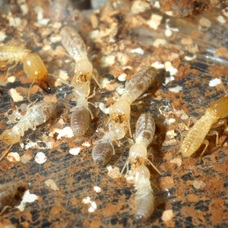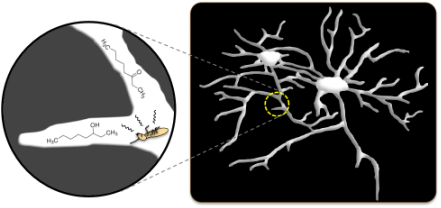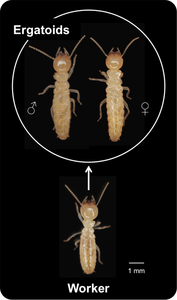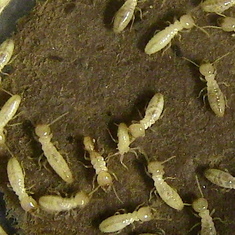Insect social behavior and evolution: Research in our lab centers on the behavior, ecology, and evolution of social insects, with an emphasis on termites. Termites (Order Blattodea) evolved eusociality 50 million years earlier than social species in Hymenoptera (ants, bees, wasps), and they are a classical and important group for understanding the evolution of eusociality. We apply integrative approaches combining perspectives from chemical ecology and molecular biology. Big questions of interest include:
Urban entomology: In addition to the fascinating nature of social insects, termites are also known for their economic importance as some species are highly destructive structural pests. As a laboratory of urban entomology, we study the biology and management of termites and other household and structural pests, with the goals of understanding various factors affecting their function and behavior and developing integrated pest management strategies.
- What are the social cues in behavioral and developmental modulation?
- What are the molecular and physiological mechanisms underlying social behavior?
- How do pheromone, behavior, and regulatory mechanisms evolve in the cockroach-termite lineage?
Urban entomology: In addition to the fascinating nature of social insects, termites are also known for their economic importance as some species are highly destructive structural pests. As a laboratory of urban entomology, we study the biology and management of termites and other household and structural pests, with the goals of understanding various factors affecting their function and behavior and developing integrated pest management strategies.
CURRENT PROJECTS
Termite chemosensation
Social evolution is integrated with the evolution of chemical communication, which is the oldest and the primary form of communications and plays an essential role in regulating fundamental behaviors. However, little is known about how chemicals are perceived in the peripheral sensory system and how chemosensory information is processed in the brain of termites. We integrate microscopic and transcriptomic approaches to characterize the chemosensory system in termites, including illustration of antennal sensilla and brain organization in different castes, and investigation of the spatial-temporal expression of chemosensory related genes. This information lays the foundation for both mechanistic studies of chemical perception and comparative studies of chemosensation across insect taxa.
Social evolution is integrated with the evolution of chemical communication, which is the oldest and the primary form of communications and plays an essential role in regulating fundamental behaviors. However, little is known about how chemicals are perceived in the peripheral sensory system and how chemosensory information is processed in the brain of termites. We integrate microscopic and transcriptomic approaches to characterize the chemosensory system in termites, including illustration of antennal sensilla and brain organization in different castes, and investigation of the spatial-temporal expression of chemosensory related genes. This information lays the foundation for both mechanistic studies of chemical perception and comparative studies of chemosensation across insect taxa.
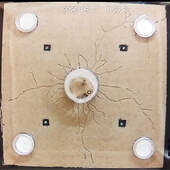
Foraging behavior in subterranean termites
Subterranean termites present a unique evolutionary history, ecological niche, and economic importance. They are wood-feeding insects that nest underground and construct extensive tunnels in soil to explore for food. The foraging behavior is a collective activity performed by workers in response to a variety of social and environmental conditions. While mechanisms of foraging behavior have been better studied in Drosophila and some social hymenopterans, the molecular bases of this behavior remain poorly understood in termites. Using the Formosan subterranean termite (Coptotermes formosanus) as a model system, we investigate the environmental regulation and molecular mechanisms of foraging behavior in termites.
Subterranean termites present a unique evolutionary history, ecological niche, and economic importance. They are wood-feeding insects that nest underground and construct extensive tunnels in soil to explore for food. The foraging behavior is a collective activity performed by workers in response to a variety of social and environmental conditions. While mechanisms of foraging behavior have been better studied in Drosophila and some social hymenopterans, the molecular bases of this behavior remain poorly understood in termites. Using the Formosan subterranean termite (Coptotermes formosanus) as a model system, we investigate the environmental regulation and molecular mechanisms of foraging behavior in termites.
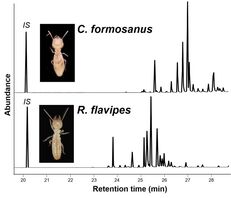
Cuticular hydrocarbons and desiccation resistance
Water availability, including soil moisture and environmental humidity, is a critical abiotic factor for the survival and behavior of subterranean termites. As in other insects, termites produce cuticular hydrocarbons (CHCs) as a waterproofing lipid layer to prevent water loss. Insect CHCs play important roles in both desiccation resistance and chemical communication, and they are highly diverse across species and plastic in response to environmental variations. We study the mechanisms of CHC production and its role in desiccation resistance to understand how different subterranean termite species adapt to the environment.
Water availability, including soil moisture and environmental humidity, is a critical abiotic factor for the survival and behavior of subterranean termites. As in other insects, termites produce cuticular hydrocarbons (CHCs) as a waterproofing lipid layer to prevent water loss. Insect CHCs play important roles in both desiccation resistance and chemical communication, and they are highly diverse across species and plastic in response to environmental variations. We study the mechanisms of CHC production and its role in desiccation resistance to understand how different subterranean termite species adapt to the environment.
COLLABORATIVE PROJECTS
Honey bee health (with Kate Ihle)
We are collaborating with Dr. Kate Ihle from the USDA Bee Lab to study honey bee health from the perspectives of genetics and breeding. We integrate molecular biology and chemical ecology approaches to understand mechanisms underlying queen health.
We are collaborating with Dr. Kate Ihle from the USDA Bee Lab to study honey bee health from the perspectives of genetics and breeding. We integrate molecular biology and chemical ecology approaches to understand mechanisms underlying queen health.
Stored rice IPM (with Blake Wilson)
We are collaborating with Dr. Blake Wilson to develop best management practices for insect pests of stored rice. This research will provide information for reducing impact of stored grain pests to the Louisiana rice industry by identifying more effective and efficient controls.
We are collaborating with Dr. Blake Wilson to develop best management practices for insect pests of stored rice. This research will provide information for reducing impact of stored grain pests to the Louisiana rice industry by identifying more effective and efficient controls.
RESEARCH PROJECTS PRIOR TO LSU
Undertaking behavior
|
Cannibalism or burial
Undertaking behavior, the disposal of dead colony members, is a stereotypic behavior in many social insects to prevent potential pathogenic attack. Ants and honey bees carry deceased members out of the nest, but termites that feed on nitrogen-limited woody diet could benefit from recycling rather than discarding nutrients from dead nestmates. My Ph.D. research demonstrated that termites alternatively cannibalize or bury corpses based on their origin and postmortem time. They retrieve and consume freshly dead conspecifics, but bury corpses of competitive species. In addition, termites bury dead conspecifics if they are highly decomposed. Combined results from behavioral observations and brain transcriptomic profiling indicate that cannibalism is not only nutritionally beneficial, but also more energetically efficient than burial. (Watch YouTube movies for how termites manage corpses of different origins and postmortem times, and see a poster for transcriptomic analysis.) |
|
Death cue
The exploration of death cues in social insects was pioneered by E. O. Wilson in 1958. Since then, postmortem accumulation of fatty acids has been demonstrated to trigger corpse removal in several ants. As a part of my Ph.D., I identified the dynamic changes of death cues in termites. Immediately after death, the corpse releases a blend of volatiles, 3-octanone and 3-octanol, which attract live workers to retrieve and consume the bodies. The early death cue decreases quickly as the corpse decomposes. Correspondingly, the accumulation of late death cues (fatty acids, phenol, indole) elicits a behavioral switch from cannibalism to burial. The dynamic change in death cues balances nutritional rewards and pathogenic risks. This postmortem chemical communication highlights unique adaptations in termites to their ecological and social niche. |
|
Worker-reproductive transition
|
Reproductive pheromones In social organisms, individual development exhibits strong plasticity depending on the social environment. In many termite species including R. flavipes, workers are reproductively totipotent. They can differentiate into ergatoid reproductives, and continue reproduction after the death of primary queen and king. Reproductive pheromones that inhibit worker-reproductive transition have been suggested, but my study showed exciting results with evidences of both inhibitory and stimulatory substances influencing ergatoid formation. Potential sources and types of these pheromones (e.g., proctodeal fluid, cuticular hydrocarbons, and volatile substances) have been examined. This research will improve our understanding of reproductive division of labor in termites, one of the few hemimetabolous eusocial insects with bisexual colonies. |
|
Policing behavior
Reproductive conflict widely occurs in eusocial species where workers are reproductively totipotent. It is particularly true in termites during the process of reproductive succession, as conflict arises when the number of ergatoids exceeds the limit that colony can sustain. Termites resolve the conflict by killing excessive ergatoids, a previously poorly studied behavior. We addressed several questions including who kill the ergatoids, whether the attack is sex-specific, and whether it is age-dependent. Observations and experiments showed that policing behavior in R. flavipes is a concerted effort carried out by both ergatoids and workers, and the policing by ergatoids is age-dependent. Specially, older ergatoids attack younger ones, and workers are then recruited to cannibalize the injured ergatoids. This study provided the first empirical evidence of policing behavior in termites. |
Before becoming a social insect enthusiast, I studied earthworm diversity when I was a Master’s student, and Maillard reaction when I was an undergraduate at China Agricultural University in Beijing.

